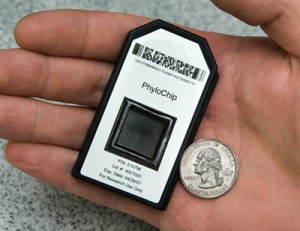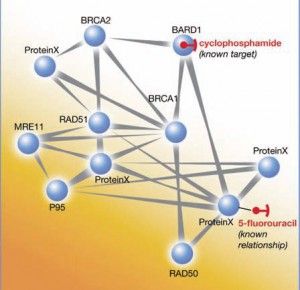Contact: Pam Seidenman, (510) 486-6461, [email protected]
BERKELEY, CA — Four of R&D Magazine’s prestigious R&D 100 Awards for 2008, which recognize the 100 most significant proven technological advances of the year, have gone to researchers at the U.S. Department of Energy’s Lawrence Berkeley National Laboratory and their colleagues.
The awards bring the total of Berkeley Lab’s R&D 100 awards — also called the “Oscars of Invention” — to 48, plus two Editors’ Choice Awards over the years.
The 2008 award designees are:
- Berkeley Lab PhyloChip — a DNA microarray that quickly, comprehensively, and accurately identifies species within microbial samples from any environmental source, without any culturing required.
- Biomimetic Search Engine — a search engine that mimics the human cognitive process to find hidden and contextually relevant information in literature, databases, music, and other digital content.
- FastBit Bitmap Index — the fastest indexing technology for accelerating searching operations of massive databases. FastBit is able to search up to 100 times faster than other technologies.
- Nanostructured Polymer Electrolyte for Rechargeable Lithium Batteries — a polymer electrolyte that enables the development of rechargeable lithium metal batteries with energy density that is at least a factor of two larger than that of existing technology.
Cheryl Fragiadakis, who heads Berkeley Lab’s Technology Transfer and Intellectual Property Management Department, says, “Winning four awards is a tremendous achievement that speaks very highly of the strength of our science and its relevance to solving complex global problems. I am particularly pleased to note that this year’s winners are already being used or further developed by partners in the private sector.”
Berkeley Lab Phylochip
The PhyloChip packs an enormous amount of analytical power into a device not much larger than a quarter. Its ability to test all manner of environmental samples for their microbial content is unprecedented. It allows scientists to detect what was undetectable before now, at a speed inconceivable before now. It was developed by Gary Andersen, Todd DeSantis, Eoin Brodie, and Yvette Piceno of Berkeley Lab’s Earth Sciences Division.
The PhyloChip’s contributions to public health, medical diagnostics, and environmental cleanup projects have already paid large dividends. The information that it has already provided about the airborne bacterial content above U.S. cities is a first step in distinguishing between a climate-related bacterial change and a real bioterrorist threat. It promises even more advances in the development of biofuels and carbon sequestration. In short, scientists are continually finding new ways to use the PhyloChip, and make significant new discoveries along the way.
Biomimetic Search Engine
The Biomimetic Search Engine is the only search engine that couples the way people learn with the unmatched speed and data storage capabilities of computers. In doing so, it is revolutionizing how digital content is searched and utilized. Users can search huge databases and determine how objects are related, in what contexts they are related, and the strengths of those relationships. It was developed by Kasian Franks and Connie Myers, formerly of Berkeley Lab’s Life Sciences Division, and Raf Podowski. Both Franks and Podowski are now with the Emeryville, CA-based start-up company SeeqPod. A music search engine using the Biomimetic Search Engine can be found at www.seeqpod.com.
The Biomimetic Search Engine goes far beyond simply sifting through data for keywords. Instead, the system allows users to make previously unknown connections between seemingly unrelated terms. In this way, it helps to synthesize new information and further a person’s understanding of a given topic, which is the hallmark of discovery, innovation, and invention. The Biomimetic Search Engine is already revolutionizing how genomics data, the internet’s playable music and video files, and Wikipedia’s ever-growing content are searched and utilized. It is also poised to make inroads into the finance, sports, and health sectors.
FastBit Bitmap Index
FastBit significantly advances the state of the art in searching large datasets. It expands the types of data on which bitmap indexes can be used most efficiently, while at the same time it speeds up search operations on all types of data. It was developed by Kesheng Wu, Arie Shoshani, Ekow Otoo, and Kurt Stockinger of Berkeley Lab’s Computational Research Division
FastBit has improved the speed of drug-discovery software at the University of Hamburg, Germany, and improved the matching between web page content and advertisements at Yahoo! Research. A FastBit-enabled grid-based analysis of high-energy physics data received an award from the 2005 International Supercomputer Conference in Heidelberg, Germany, and the work on network traffic analysis received an honorable mention in the High Performance Analytics Challenge at the Supercomputing 2005 conference in Seattle. In short, FastBit contains significant innovations that are well-recognized and have a broad impact in science, technology, and education.
Nanostructured Polymer Electrolyte for Rechargeable Lithium Batteries
Until now, rechargeable battery architectures that include solid electrodes and liquid electrolytes have not advanced far beyond what they were at the birth of the first batteries. That’s beginning to change, thanks to solid-state batteries containing a nanostructured polymer electrolyte. The technology introduces a radically new architecture with a potential to enable electric battery-driven transportation technology. It was developed by Nitash Balsara, a scientist in Berkeley Lab’s Materials Sciences Division who also conducts research with the Lab’s Environmental Energy Technologies Division. He’s also a professor in UC Berkeley’s Department of Chemical Engineering. The technology has been licensed to the start-up company Seeo Inc., located in Berkeley, CA.
The nanostructured polymer electrolyte exhibits high ionic conductivity, but can be engineered to be mechanically rigid, therefore resisting the growth of dendrites when contacted with a lithium metal electrode. Dendrite growth has prevented the commercialization of rechargeable batteries with a lithium metal anode. Batteries made with the nanostructured polymer electrolyte are also inherently safe because they lack liquids and flammable components, which prevent thermal runaway. In addition, products of side reactions cannot circulate and amplify within the cell. Solid-state lithium-ion batteries made possible by Berkeley Lab’s nanostructued polymer electrolyte are expected to meet the energy density goal established by the Department of Energy for electric vehicles — the highest hurdle for battery technology.
The R&D 100 Award-winning technologies were nominated by Berkeley Lab’s Technology Transfer and Intellectual Property Management Department. All winners of the 2008 award will receive a plaque at R&D Magazine’s formal awards banquet in Chicago on October 16.
Berkeley Lab is a U.S. Department of Energy national laboratory located in Berkeley, California. It conducts unclassified scientific research and is managed by the University of California. Visit our website at www.lbl.gov.

